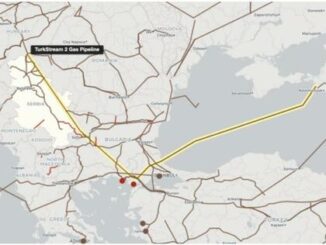
Saudi Arabia and Russia have raked in billions of dollars in extra oil revenues in recent months, despite pumping fewer barrels, after their production cuts sent crude prices soaring.
The cutbacks were a risky strategy, both financially and politically. But they appear to be paying off for the two most important members of the Organization of the Petroleum Exporting Countries and its Russia-led allies, or the OPEC+ cartel. Price increases are more than making up for the reduction in sales volume, according to calculations by consulting firm Energy Aspects.
The inflows are helping Saudi Arabia, under Crown Prince Mohammed bin Salman, fund pricey domestic projects and continue an investment-driven campaign of overseas influence. The extra funds are also ensuring Russian President Vladimir Putin can sustain his war in Ukraine.
Oil revenues in Saudi Arabia this quarter are likely up by nearly $30 million a day compared with the April-June period, or an increase of about 5.7%, analysis by Energy Aspects shows. For the whole three-month period, that would equate to about $2.6 billion. Russian oil revenues are likely up by about $2.8 billion, the data shows.
These successes could prompt the cartel to consider even more restrictions to global supply, some market watchers say. “OPEC+ is very much in the driver’s seat. You could argue there’s even more to come,” said Saad Rahim, chief economist at Trafigura.
The cartel has been raising the pressure on oil markets for months, but until recently its actions were offset by worries about a global recession and sluggish Chinese growth, which kept oil prices trading in a fairly narrow range.
Last October, members said they would slash production by 2 million barrels a day, the biggest cut since the start of the pandemic. In May, a smaller, Saudi-led group introduced a second cut of more than 1 million barrels a day. The kingdom added a further 1-million-barrel-a-day cut in July. Then, Saudi Arabia and Russia said on Sept. 5 that they plan to extend their cuts through the end of the year.
Global benchmark Brent crude has climbed 25% this quarter and traded as high as $95 a barrel in recent days, though it has recently pulled back modestly. The most actively traded contract closed at $94.36 on Wednesday.
OPEC+ forecasters predict a global deficit of 3.3 million barrels a day in the fourth quarter, and many oil analysts now expect benchmark Brent to soon top $100 a barrel.
“It’s not such a bold call anymore,” said Livia Gallarati, an oil-markets analyst at Energy Aspects. “Prices are going to be grinding higher. Supply is fundamentally tight.”
A strategy to reduce output is risky because a big oil producer can lose market share to rival nations—and, if the shortfall fails to boost prices, can suffer a big drop in revenue. High energy costs are also unpopular in Washington, since they could introduce fresh inflationary pressures into the U.S. economy.
Production costs are low in Saudi Arabia and Russia, averaging $9.30 and $12.80 a barrel respectively last year, according to Rystad Energy estimates. Those low costs mean most of the revenue from oil exports can be converted into profit.
The higher prices are welcome for Saudi Arabia, which has a history of booms and busts linked to oil-market swings and a mixed record with big development projects partly as a result.
The country has stepped up capital outlays, spending 37% more in the first half of 2023 on capital expenditures than it did in the same period last year, according to Capital Economics. Work has started on a $500 billion megaproject for 2030, the new city-state of Neom, which is planned to be the size of Massachusetts.
The International Monetary Fund estimated earlier this year that Riyadh’s break-even oil price to balance its budget is about $81 a barrel. If Saudi Arabia keeps struggling to attract foreign investment to projects such as Neom, the break-even could rise closer to $100, analysts say.
Russia, meanwhile, is spending heavily to fight the war in Ukraine. In the first quarter of this year, spending jumped 35%, increasing by nearly two trillion rubles, or some $20.7 billion, compared with a year earlier, according to Oxford Economics. The government has run a budget deficit since the middle of last year.
Russia’s most popular oil variety, known as Urals, has traded above $75 a barrel in recent days. That is up from the second-quarter average of $56 reported by Russia’s central bank, and above a $60 cap imposed by the Group of Seven advanced nations to curb Russian oil revenues.
Last week, the Kremlin banned diesel and gasoline exports, adding a constraint to world energy supplies. Global diesel prices jumped, on worries about scarcer volumes in an already tight market.
“This is Russia weaponizing energy again,” said Helima Croft, head of commodity strategy at RBC Capital Markets. With markets for petroleum products “incredibly tight, this is really something to be concerned about,” she said. A fight between the Kremlin and oil companies including Rosneft because of fuel shortages was another factor in the ban, The Wall Street Journal reported.
Some economists still predict growth will slow in Saudi Arabia and Russia because of the production cuts. But that largely reflects a quirk in how real, or inflation-adjusted, gross domestic product is calculated, said James Swanston, an economist at Capital Economics. This measure of economic output is computed using volumes rather than prices, he said.
“If we just look at oil prices, their future’s looking brighter,” Swanston said. “It might not be an economic game-changer, but it does let them keep spending.”
ENB Top News
ENB
Energy Dashboard
ENB Podcast
ENB Substack



